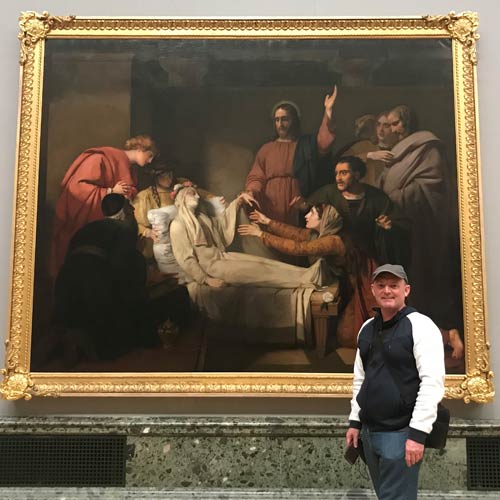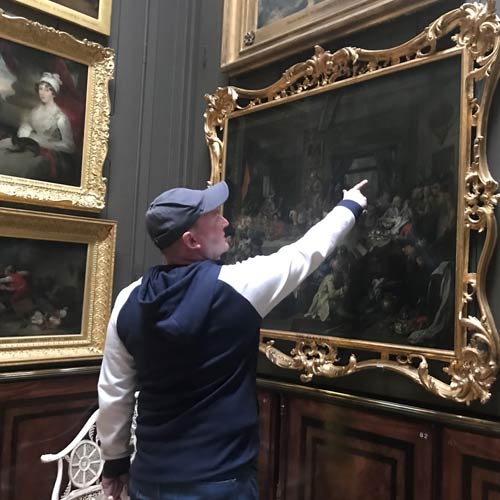The Bible, Art and Literature
‘See, I have called by name Bezalel the son of Uri, the son of Hur, of the tribe of Judah and I have filled him with the Spirit of God, in wisdom, in understanding, in knowledge, and in all manner of workmanship, to design artistic works, to work in gold, in silver, in bronze, in cutting jewels for setting, in carving wood, and to work in all manner of workmanship’ (Exodus 31:2-5).






The Bible is replete with stories of lives filled with joy, music, colour, poetry, prose and dance. Just ponder the Psalmists weaving words for God’s glory and David dancing before the Lord, or Solomon opening the Temple in Jerusalem suffused with ornate carvings.
The Spirit of God filled Bezalel to ‘design artistic works’ for God’s glory and the Lord still speaks through the Bible, His Spirit, preaching, creation and the arts. William Holman Hunt’s The Light of the World, portraying Christ knocking on a door from Revelation 3:20, is one of the cardinal evangelist images of all time. The door deliberately has no handle on the outside; like our hearts, it has to be opened from within.
“Art is born when the temporary touches the eternal,” said G.K. Chesterton. Art represents a universal language, mastered by Christians to testify, evangelise, disciple and worship God.
We capture creation because creation is God’s art gallery. “God varnishes the sky with a celestial exhibition at sunrise and sunset,” said Paul Backholer. “When J.M.W Turner captured a sunset on canvas, he garnered from the handiwork of the sumptuous Creator. The interplay of light and colour coalesce in his masterpieces, stressing the ephemeral nature of life. Today is the day of salvation.”
Christ is the ultimate Creator, utilising creation as His canvas, as Colossians 1:16 conveys. God endowed humans with His creative instincts, so it’s logical we desire to create. Michelangelo’s Sistine Chapel, Rembrandt’s Return of the Prodigal Son, Da Vinci’s The Last Supper, Bunyan’s Pilgrim’s Progress and Milton’s Paradise Lost all manifest from the seed planted by the Creator in His human masterpieces.
Christians have rightly shunned art when it becomes idolatrous, but as God’s anointing on Bezalel proves, we should not cede art, literature and architecture to high-brow atheists to manipulate for spiritual destruction. The early Church Fathers shunned sinful art, but recognised God’s handiwork. Clement of Alexandria AD c.150-c.215 said, “What is good in the arts…has its beginning from God.”
Our art galleries and ancient books are filled with God. The National Gallery in London, England, is an indelible Church where paintings preach; roughly one-third of its artworks are Christian.
“Jesus Christ and His teaching shaped our history,” said Mathew Backholer, “merely look at historic Western culture, art, literature and architecture, and we find the story of the Bible retold, shaping our perception of reality.”
Today, controlling forces are re-writing Western history to cast Christ and His teaching as relics of an ancient culture. They republish classic books and produce films with references to Jesus Christ, Christianity and the spiritual development of the characters removed. The story of Robinson Crusoe was written to explore the spiritual development of an individual bereft from the influence of the world, and the peace Crusoe procured in Christ, but movie interpretations develop into politically correct whitewashing.
“The purpose of the arts is to bear a mirror to ourselves with the eternal vantage,” said Paul Backholer, “and to see what we have become or could be. Christians have explored Christ’s sacrifice and the meaning of discipleship through art and literature for centuries, and we felt drawn to discover this heritage.”
The ByFaith Media team began delving through historic literature and visiting art galleries, museums and private collections to discover the story of faith and the arts. “It’s remarkable how many writers and artists were devout Christians or who were inquisitive about God, as they explored Scripture and the quest for the eternal,” said Paul Backholer.
“Our first great experience of Christian art was in the catacombs of Rome,” said Mathew Backholer, “looking at the impressions persecuted Christians in the early Church made as part of their worship of God.”
ByFaith Media has built up a wealth of intimacy with the arts by witnessing Christian themes in the National Gallery, The Houses of Parliament, Tate Britain, the Wallace Collection, Sir John Soane’s Treasury, to the vast private collections held by the National Trust and the Royal Collection, and from Blenheim Palace to Buckingham Palace, also in our churches great and small, from St Paul’s to Westminster Abbey, to the Vatican. Overseas, the brothers admired ancient Christian symbols in China, and Christian art in Egypt and Ethiopia, to the role Christian symbolism played in ending Apartheid in South Africa.
“Ultimately, the role of biblical art is to extricate our gaze from the distractions of this evanescent realm to the eternal,” said Paul Backholer. “When art drives us closer to Christ, it has gratified its noble purpose.”
At ByFaith.org, you can obtain articles about the faith of notable painters, their quest for God and their struggles, plus book reviews concerning important Christian legacies in classic literature.